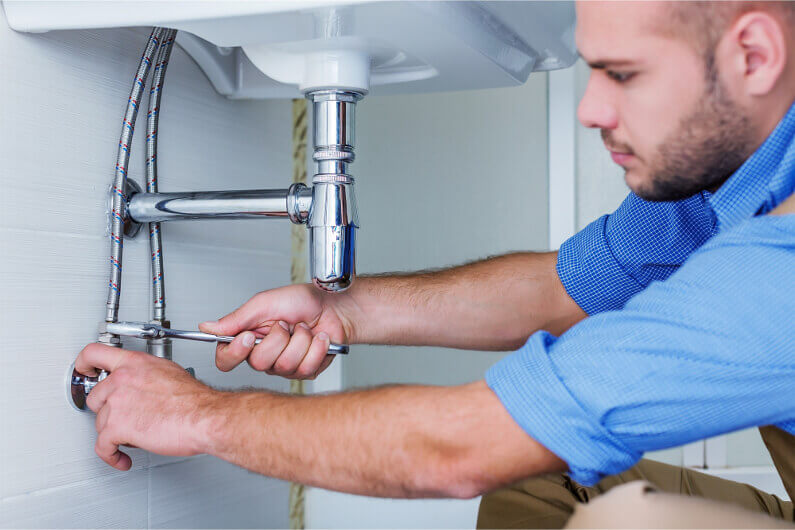Plumbing Shreveport LA is a complex network of pipes that facilitates the distribution and use of water and the removal of sewage. It is essential for a healthy, comfortable home or business. Its maintenance requires a keen eye and knowledge of the fundamental principles.
To become a plumber, you’ll need to have a high school diploma and take drafting classes or vocational training. After that, you can find an apprenticeship program that offers a competitive salary.

Plumbing is the system of pipes and other equipment that facilitates water supply and waste disposal in a building or structure. It involves installing, repairing, and maintaining these systems, as well as designing the layout of plumbing networks. Plumbing is a crucial aspect of construction, as it ensures safe and reliable water supply and drainage. It also protects against water damage, mold growth, and health hazards. If your plumbing is not working properly, it can lead to costly repairs and inconvenience for the occupants of your building.
Plumbing work is a complex and varied field that includes pipe installation, repair, and maintenance. It involves everything from piping for hot and cold water to sewers and drains. It also encompasses the installation of appliances and fixtures. It can be challenging to navigate the complexities of plumbing, so it is important to have a good understanding of how these systems work before you get started.
Most plumbers work as independent contractors or run their own businesses. This allows them to have greater control over their schedules and the projects they take on. However, this can also make it difficult to find steady work. Moreover, the nature of plumbing work means that plumbers may have to work evenings and weekends in emergency situations.
Plumbing is a highly technical field that requires extensive training and certification. It also demands a high level of physical fitness. Plumbers must be comfortable lifting heavy objects and working in cramped spaces. In addition, they must be able to troubleshoot problems quickly and accurately. Finally, they need to follow strict safety standards to avoid injury or exposure to hazardous materials. The demand for plumbing services fluctuates with the economy and with the construction industry. When the demand for new constructions decreases, so does the need for plumbing services.
Drains are the holes through which water is carried away
When you think of plumbing, your mind might conjure images of sinks, toilets, and showers. But the truth is that plumbing extends much farther than these fixtures. It involves the network of pipes and valves that transport water throughout a building or structure. Its purpose is to provide potable (clean) drinking water and remove waste water and sewage. In order to function properly, a plumbing system must be well-maintained and regularly checked for leaks.
Water supply systems, which deliver pressurized freshwater to homes and buildings, are also part of the plumbing system. They are regulated by valves and pipe materials such as copper, PVC, or PEX. These pipes transport clean water to various fixtures and appliances, such as faucets, showers, and dishwashers.
Drainage systems, on the other hand, are based on gravity and do not rely on pressure. The waste matter leaves the house because the drainage pipes pitch, or angle downward, towards a sewer line. From here, the waste is funneled into a septic tank or a sewage treatment plant.
In some cases, doctors may insert a drain to evacuate pus or blood from an infection or abscess. These drains are called “active” or “percutaneous” drains, and they are often used to treat intra-abdominal infections. There are many different types of active drains, including Jackson-Pratt drains and hemovac drains. Commercially available closed suction Jackson-Pratt drains use a collapsible grenade-style collection reservoir that applies negative pressure through radiopaque fenestrated tubing (FIGURE 4). This constant negative pressure decreases the opportunity for bacteria to grow in static fluid and promotes drainage. If you are using a percutaneous drain, check any written instructions for drain management and monitor the patient closely for signs of infection at the insertion site.
Pipes carry water
The water supply line that brings fresh, clean water to your home is one of the most important parts of your plumbing system. It’s also the main source of pressure that pushes water around corners in your pipework and provides the water flow needed to flush toilets, operate faucets, and supply hot water to your showers and bathtubs.
Pipes come in a variety of materials and are designed to meet different needs. For instance, galvanized steel pipes are ideal for distributing gas to homes. They’re durable and have a zinc coating that protects them from corrosion in wet environments. But they’re not the best choice for water distribution. These pipes can lose their protective zinc coating and develop leaks over time.
Other types of pipes include plastic PE and PP, as well as cast iron and copper. These pipes are more flexible and can be bent to accommodate bends in the pipe run. Moreover, they can be assembled using push-on joints. However, these joints require the use of a special pipe joint lubricant. In addition, buried underground pipes are often joined using flared K copper and mechanical joints.
In the past, most homes used copper pipes for their water supply lines. But the copper was expensive and had a reputation for being susceptible to corrosion. For these reasons, more homeowners have turned to the more affordable plastic PEX. PEX is also able to withstand high water pressure, making it an ideal choice for residential plumbing systems.
The first step in designing a pipe layout is to determine the number of water supply fixture units (WSFU) served by each piping section. This value is established by the governing plumbing code. After this, you can calculate the required piping size and type.
Pipes carry waste water from the fixtures
A plumbing system includes a network of pipes for carrying water and waste away from the fixtures. It also carries sewage from houses to the city sewer line. A plumbing contractor can install, repair, and maintain this system.
When fresh water enters a house, it flows along hot and cold water supply lines to each fixture. The pipes are made of copper, iron or plastic and are usually under pressure. This allows them to travel up and around corners. The pressure is also needed to force the water through the pipes at a faster rate. This is important in order to supply the fixtures with enough water quickly.
After the water leaves a fixture, it travels down the drain pipe. Each drain has a curved section that prevents waste gases from traveling back up the pipe. This is called a trap. Each fixture drain pipe has a P-trap or an S-trap (S-traps are now illegal according to the U.S. Uniform Plumbing Code). The traps seal the hole in the bottom of a pipe to keep out small animals and sewer gas. The piping also connects to horizontal branch drain pipes concealed inside the walls. The branches then connect to a larger vertical pipe called a stack.
The DWV system also contains vent pipes that extend through the roof. These allow air to enter the piping and help the DWV system work properly. Without venting, odors and sewer gases could be released into the house. These pipes also provide oxygen for the aerobic breakdown of sewage.
A plumbing system is complex, but it’s important to understand how it works. This will allow you to make repairs and reduce waste. It’s also vital to know how to recognize problems and hire a professional plumber when necessary.
Pipes carry gas
Pipes are a key element of any piping system. They are hollow cylinders that carry liquids and gases, as well as slurries and powders. They are also often used for structural applications, as they are far stiffer per unit weight than solid members. They can be made from a variety of materials, but metal pipes are the most common because they are strong and durable. They can withstand high pressures and are resistant to corrosion. Plastic pipes are also gaining popularity, as they are inexpensive, easy to install, and can withstand a higher amount of pressure than metal ones.
Gas pipes are generally made of steel or black iron and can be found in residential and commercial buildings. They can be used to supply natural gas or propane, and they are usually buried underground to avoid causing damage to the environment. Typically, these lines are buried between 18 and 24 inches deep. The depth of the line is regulated by local governments to prevent soil shifts or earthquakes from damaging the pipelines.
Pipes that transport gas to customers are usually made of rolled, high-carbon steel. They are also designed to withstand a high level of pressure and must meet government and industry safety standards. They are usually built in sections, with gathering lines and transmission lines separated from distribution lines by a gap of at least 40 to 80 feet.
Pipes can be made from a wide range of materials, including stainless steel, copper, and even plastic. A new type of piping is aluminum-plastic composite, which combines the strength of aluminum with the flexibility of plastic to make a stronger, more flexible pipe. This type of pipe is gaining popularity in the natural gas industry because it is safer than other types of pipes.
